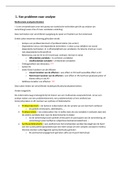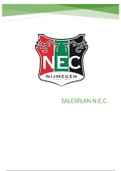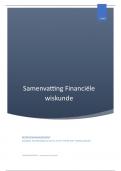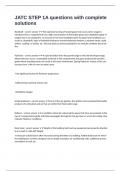SERVICES MARKETING 324 A1 NOTES
Chapter 1
1. Explain what services are and identify important trends in services.
- All economic activities whereby the output is not a physical product
- Consumed at time of production
- Provides added value that is essentially intangible for first purchaser (e.g.,
amusement, health, comfort, convenience)
- E.gs: transport, medical/healthcare, entertainment, education, public
- Interacting with Activities, Processes, Performances delivered by people,
organisations and technology to achieve desired outcomes
- Not tangible things, rather intangible activities
- Lovelock’s classification: tangible vs intangible recipients
- TANGIBLE actions
o Services directed at people’s bodies:
§ require customer present
§ expansion requires premises, equipment & employees
o Services directed at tangible possessions:
§ does not require customer present
§ expansion requires premises, equipment & employees
- INTANGIBLE actions
o Services directed at people’s minds:
§ service provider does not necessarily have to active at the same time
§ e.g., customer can use Netflix on the internet which is not at site of
Netflix’s production
o Services directed at intangible assets/possessions:
§ almost no direct interaction between customer & service provider
§ e.g., banking, accountancy, insurance.
- Tangibility spectrum: ranging from tangible dominant (shoes, fast food, chemicals)
to intangible dominant (airlines, education, insurance, consulting)
,2. Explain the need for special services marketing concepts and why the
need has developed and is accelerating.
Services contexts
- Services as organisations: pure services offered by these companies e.g., banking,
airplane companies (Lufthansa), hotels (Ibis)
- Services as products: intangible service product offerings e.g. IT consulting services,
travel services, insurance services
- Services as experiences: e.g. Disneyland Paris, boutique hotels. Product =
memory of the experience.
- Customer service: not usually paid for explicitly by the customer, a service
provided in SUPPORT of the company’s core service. E.g. hotlines, call-centres
- Transformative services: create positive changes ,focus on improving the well-
being of individuals, communities, ecosystems, not only for today but also for the
future. Better policing, vaccination drives, festivals, public transport
WHY need has developed:
- Traditional services sector has evolved
- More competitive now
- Need effective services marketing strategies to compete internationally
- Difficult to gain competitive advantage through technologies alone, since they are
developed so quickly & the amount of competition increases very quickly
- Customers are also now more demanding – expect high levels of customer service
,3. Introduce the concept of service dominant logic.
Service dominant logic: **about MANNER regarding value creation**
- Value is not simply created and delivered to the customer
- Rather co-created in a process that requires active participation from producer,
consumer and other stakeholders
- Knowledge of both producers and consumers combined create the value creation,
rather than the products on their own (as in traditional goods sense)
Value-in-use: **about TIME of value creation**
- Value not created at time of exchange between producer and consumer
- Rather, value is created when the customer integrates, experiences and uses the
resources of a producer
o Example: Car only has value if it can get people to work, communicate
someone’s self-image or be a source of freedom for users
- External influences: e.g. customer buys a car
o Varies from customer to customer:
§ driving skills, care of car, knowledge about cars, knowledge of
destinations, etc.
o Varies depending on time and place:
§ fuel prices, rules of the road, government laws, traffic in certain
places, speed limits
Value creation process:
- Provider sphere: producer compiles resources to act as source as value creation
for consumers
- Joint sphere: producer + consumer interact directly
- Consumer sphere: customer independently creates value through use and
experiences without service provider
, 4. Explore the profound impact of technology on service.
- Innovative service offerings: connected car, voice assistants, artificial
intelligence, medical professionals use technologies to keep track & diagnose
patients
- New vehicles of service delivery:
o More accessible and convenient
o Functions: paying for bills, SnapScan, online banking e.g. Investec app,
tracking parcels on Superbalist
o Purchases: online shopping
o Research and learning e.g. WebMD
- Enabling both customers and employees: self-service tech (online banking);
employees can better deliver services (reviews); smart cities (traffic lights, warnings,
IoT: Internet of Things)
- Extending global reach of services: internet has no boundaries, therefore
customer service info can reach anyone who has access to the internet. Easier to
stay in touch e.g. virtual teams.
- The internet is a service: provides info, performs basic customer functions,
facilitates transactions, e-commerce stores, etc. Customers still want basic service.
- Paradoxes and dark side of the internet: privacy and confidentiality issues;
employees can be reluctant as technology replaces human labour (e.g. online
banking); lack of face-to-face content – issue for parents (kids spend hours on
screens) & employees (email colleague in the next room) = lack of personal
relationships; payback time on tech investments is often quite long.
5. Outline the basic differences between goods and services and the
resulting challenges and opportunities for service businesses.
Goods Services
Tangible Intangible
Standardised Heterogeneous
Production separate from Inseparable: production and
consumption consumption are simultaneous
Non-perishable Perishable
- Intangibility: services cannot be touched, tasted, felt or seen since they are actions
or performances. Tangible components of the service (e.g. hospital equipment in a
theatre) may sometimes be seen and touched.
o Marketing implications: cannot be patented, can easily be copied, cannot be
displayed, difficulty choosing promotional materials, pricing difficult to
determine (no ‘units’ or raw material costs)
- Heterogeneity: no 2 services will be precisely alike, and no 2 customers are precisely
alike (different demands). Heterogeneity results due to human interaction between
employees and customers e.g. tax accountant deals with 2 customers differently
based on their individual needs
Chapter 1
1. Explain what services are and identify important trends in services.
- All economic activities whereby the output is not a physical product
- Consumed at time of production
- Provides added value that is essentially intangible for first purchaser (e.g.,
amusement, health, comfort, convenience)
- E.gs: transport, medical/healthcare, entertainment, education, public
- Interacting with Activities, Processes, Performances delivered by people,
organisations and technology to achieve desired outcomes
- Not tangible things, rather intangible activities
- Lovelock’s classification: tangible vs intangible recipients
- TANGIBLE actions
o Services directed at people’s bodies:
§ require customer present
§ expansion requires premises, equipment & employees
o Services directed at tangible possessions:
§ does not require customer present
§ expansion requires premises, equipment & employees
- INTANGIBLE actions
o Services directed at people’s minds:
§ service provider does not necessarily have to active at the same time
§ e.g., customer can use Netflix on the internet which is not at site of
Netflix’s production
o Services directed at intangible assets/possessions:
§ almost no direct interaction between customer & service provider
§ e.g., banking, accountancy, insurance.
- Tangibility spectrum: ranging from tangible dominant (shoes, fast food, chemicals)
to intangible dominant (airlines, education, insurance, consulting)
,2. Explain the need for special services marketing concepts and why the
need has developed and is accelerating.
Services contexts
- Services as organisations: pure services offered by these companies e.g., banking,
airplane companies (Lufthansa), hotels (Ibis)
- Services as products: intangible service product offerings e.g. IT consulting services,
travel services, insurance services
- Services as experiences: e.g. Disneyland Paris, boutique hotels. Product =
memory of the experience.
- Customer service: not usually paid for explicitly by the customer, a service
provided in SUPPORT of the company’s core service. E.g. hotlines, call-centres
- Transformative services: create positive changes ,focus on improving the well-
being of individuals, communities, ecosystems, not only for today but also for the
future. Better policing, vaccination drives, festivals, public transport
WHY need has developed:
- Traditional services sector has evolved
- More competitive now
- Need effective services marketing strategies to compete internationally
- Difficult to gain competitive advantage through technologies alone, since they are
developed so quickly & the amount of competition increases very quickly
- Customers are also now more demanding – expect high levels of customer service
,3. Introduce the concept of service dominant logic.
Service dominant logic: **about MANNER regarding value creation**
- Value is not simply created and delivered to the customer
- Rather co-created in a process that requires active participation from producer,
consumer and other stakeholders
- Knowledge of both producers and consumers combined create the value creation,
rather than the products on their own (as in traditional goods sense)
Value-in-use: **about TIME of value creation**
- Value not created at time of exchange between producer and consumer
- Rather, value is created when the customer integrates, experiences and uses the
resources of a producer
o Example: Car only has value if it can get people to work, communicate
someone’s self-image or be a source of freedom for users
- External influences: e.g. customer buys a car
o Varies from customer to customer:
§ driving skills, care of car, knowledge about cars, knowledge of
destinations, etc.
o Varies depending on time and place:
§ fuel prices, rules of the road, government laws, traffic in certain
places, speed limits
Value creation process:
- Provider sphere: producer compiles resources to act as source as value creation
for consumers
- Joint sphere: producer + consumer interact directly
- Consumer sphere: customer independently creates value through use and
experiences without service provider
, 4. Explore the profound impact of technology on service.
- Innovative service offerings: connected car, voice assistants, artificial
intelligence, medical professionals use technologies to keep track & diagnose
patients
- New vehicles of service delivery:
o More accessible and convenient
o Functions: paying for bills, SnapScan, online banking e.g. Investec app,
tracking parcels on Superbalist
o Purchases: online shopping
o Research and learning e.g. WebMD
- Enabling both customers and employees: self-service tech (online banking);
employees can better deliver services (reviews); smart cities (traffic lights, warnings,
IoT: Internet of Things)
- Extending global reach of services: internet has no boundaries, therefore
customer service info can reach anyone who has access to the internet. Easier to
stay in touch e.g. virtual teams.
- The internet is a service: provides info, performs basic customer functions,
facilitates transactions, e-commerce stores, etc. Customers still want basic service.
- Paradoxes and dark side of the internet: privacy and confidentiality issues;
employees can be reluctant as technology replaces human labour (e.g. online
banking); lack of face-to-face content – issue for parents (kids spend hours on
screens) & employees (email colleague in the next room) = lack of personal
relationships; payback time on tech investments is often quite long.
5. Outline the basic differences between goods and services and the
resulting challenges and opportunities for service businesses.
Goods Services
Tangible Intangible
Standardised Heterogeneous
Production separate from Inseparable: production and
consumption consumption are simultaneous
Non-perishable Perishable
- Intangibility: services cannot be touched, tasted, felt or seen since they are actions
or performances. Tangible components of the service (e.g. hospital equipment in a
theatre) may sometimes be seen and touched.
o Marketing implications: cannot be patented, can easily be copied, cannot be
displayed, difficulty choosing promotional materials, pricing difficult to
determine (no ‘units’ or raw material costs)
- Heterogeneity: no 2 services will be precisely alike, and no 2 customers are precisely
alike (different demands). Heterogeneity results due to human interaction between
employees and customers e.g. tax accountant deals with 2 customers differently
based on their individual needs









